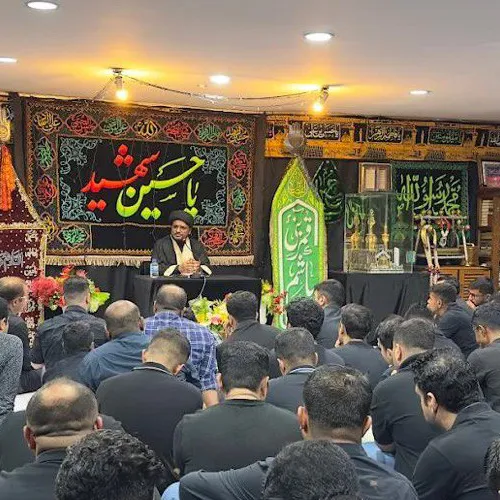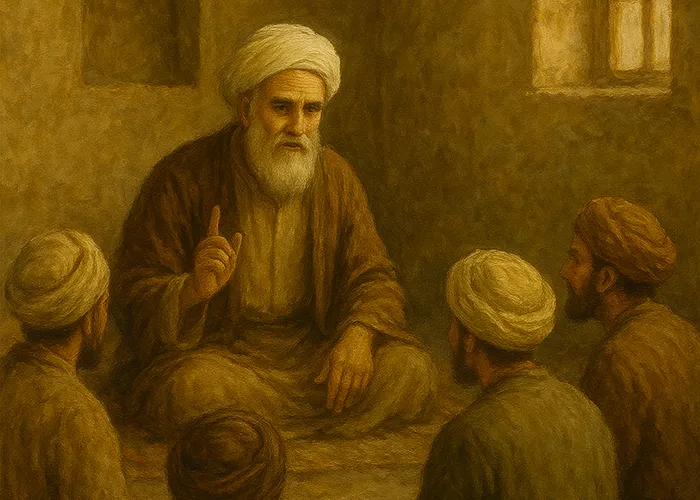Hujjat al-Islam wal-Muslimeen Sayyed Muhammad Tasdeeq Abidi
This week, we are once again blessed to be guests at the table of Muharram, seeking nourishment from the deep insights of the movement of Ashura. Our esteemed guest this week is Hujjat al-Islam wal-Muslimeen Sayyed Muhammad Tasdeeq Abidi, a scholar with rich preaching and leadership experience spanning from Asia to South America. In 2025, he was a speaker at one of the Urdu-language mourning gatherings for Imam Hussain (peace be upon him) in London. We seized the opportunity to sit down with him for a conversation.
1. Could you tell us about your activities in the role of Friday Prayer Leader (Imam Jumu’ah)?
I began serving as Imam Jumu’ah in 1998 in Alipur, India. From 2000 to 2005, I served in Bangalore, India. Then from 2005 to 2024, I was the Friday Prayer Leader in Georgetown, Guyana, South America. Currently, I am serving in Bangkok, Thailand.
2. What has been your main focus or passion in this sacred role?
In addition to the usual and essential duties, my greatest passion has been to reach out to the youth. I always strive to ensure they feel they are engaging with a friend rather than a distant cleric. My sermons have focused more on contemporary issues and socio-political analysis. I’ve also organized intellectual and recreational competitions and encouraged young people to practice writing and public speaking.
3. If Yazid had not demanded allegiance from Imam Hussain (a), would the Imam still have risen up?
Absolutely. Yazid’s rule was not only illegitimate in terms of Islamic law, but it was also politically unsound and a severe moral corruption in society. His leadership posed a direct threat to the very foundation of religion. Under such circumstances, it was incumbent upon a divinely guided Imam like Aba Abdillah al-Hussain (peace be upon him) to rise up.
4. After the tragedy of Ashura, how and by whom was the identity and message of the Ahl al-Bayt conveyed to the world?
When Imam Hussain (a) began his journey, some notable individuals such as Muhammad ibn al-Hanafiyyah advised him not to go toward Kufa and urged him at least not to take the women and children. But the Imam replied that they too had a core role in conveying the purpose of the uprising, and for that, they would need to be taken as captives. After Ashura, it became clear that without the clarifications made by the captives, the Umayyads—masters of distortion and propaganda—might have completely tarnished the image of the Imam’s movement. The regime could have lasted for centuries unchallenged. But the clarity and resistance shown by the captives and the women of the Prophet’s household ultimately led to the downfall of the Umayyads. Since then, we’ve continually witnessed the growing impact of Imam Hussain’s revolution.
5. In what ways can today’s youth take inspiration from the character of Abbas ibn Ali (a)?
The journey of Abbas ibn Ali (peace be upon him) is a timeless model for the youth. Today’s young people can draw inspiration by upholding the same values he sacrificed his life for—loyalty, absolute obedience to the divinely appointed Imam, emotional discipline, prioritizing the interests of Islam, and preserving human dignity even in the face of enemies. These are all areas where the youth can see him as a powerful role model.
6. What does it mean to say that Imam Sajjad (a) was a model of resistance beyond limitations?
It means we should never use limitations as an excuse to shirk our religious responsibilities or abandon the cultural, social, and political battlefield. For example, Imam Sajjad (a) was banned from delivering sermons and lived under a stifling atmosphere of repression. He endured immense suffering that no one else had experienced. Despite that, he found alternative methods—such as supplication and mourning over the martyrs of Karbala—to preserve and spread Islamic teachings while resisting the tyrants of his time. He pioneered new forms of struggle and left behind a legacy of innovative resistance.
editor's pick
news via inbox
Subscribe to the newsletter.




